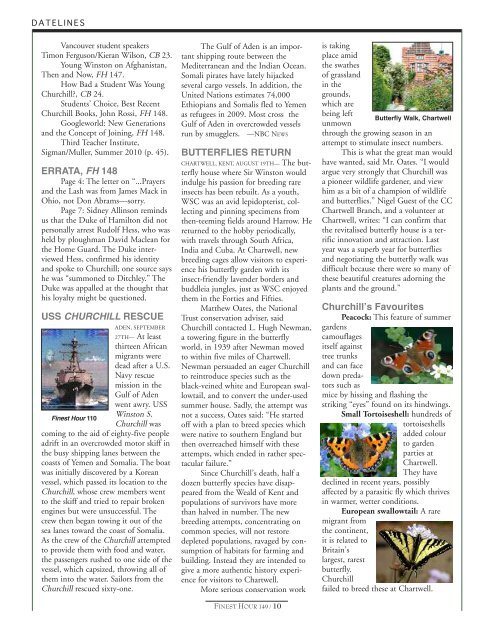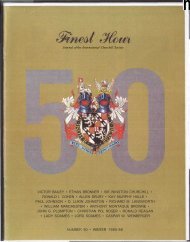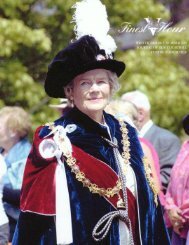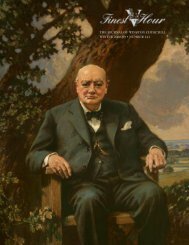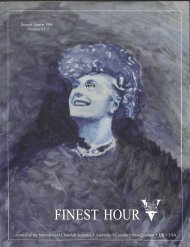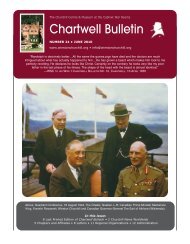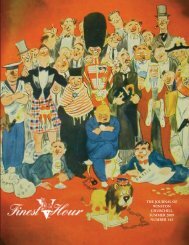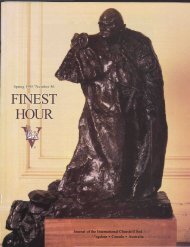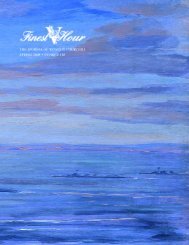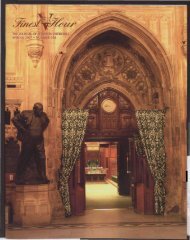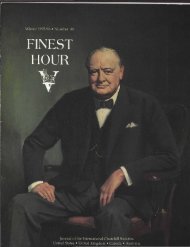You also want an ePaper? Increase the reach of your titles
YUMPU automatically turns print PDFs into web optimized ePapers that Google loves.
D A T E L I N E SVancouver student speakersTimon Ferguson/Kieran Wilson, CB 23.Young <strong>Winston</strong> on Afghanistan,Then and Now, FH 147.How Bad a Student Was Young<strong>Churchill</strong>?, CB 24.Students’ Choice, Best Recent<strong>Churchill</strong> Books, John Rossi, FH 148.Googleworld: New Generationsand the Concept of Joining, FH 148.Third Teacher Institute,Sigman/Muller, Summer 2010 (p. 45).ERRATA, FH 148Page 4: The letter on “...Prayersand the Lash was from James Mack inOhio, not Don Abrams—sorry.Page 7: Sidney Allinson remindsus that the Duke of Hamilton did notpersonally arrest Rudolf Hess, who washeld by ploughman David Maclean forthe Home Guard. The Duke interviewedHess, confirmed his identityand spoke to <strong>Churchill</strong>; one source sayshe was “summoned to Ditchley.” TheDuke was appalled at the thought thathis loyalty might be questioned.USS CHURCHILL RESCUEADEN, SEPTEMBER27TH— At leastthirteen Africanmigrants weredead after a U.S.Navy rescuemission in theGulf of Adenwent awry. USS<strong>Winston</strong> S.Finest Hour 110<strong>Churchill</strong> wascoming to the aid of eighty-five peopleadrift in an overcrowded motor skiff inthe busy shipping lanes between thecoasts of Yemen and Somalia. The boatwas initially discovered by a Koreanvessel, which passed its location to the<strong>Churchill</strong>, whose crew members wentto the skiff and tried to repair brokenengines but were unsuccessful. Thecrew then began towing it out of thesea lanes toward the coast of Somalia.As the crew of the <strong>Churchill</strong> attemptedto provide them with food and water,the passengers rushed to one side of thevessel, which capsized, throwing all ofthem into the water. Sailors from the<strong>Churchill</strong> rescued sixty-one.The Gulf of Aden is an importantshipping route between theMediterranean and the Indian Ocean.Somali pirates have lately hijackedseveral cargo vessels. In addition, theUnited Nations estimates 74,000Ethiopians and Somalis fled to Yemenas refugees in 2009. Most cross theGulf of Aden in overcrowded vesselsrun by smugglers. —NBC NEWSBUTTERFLIES RETURNCHARTWELL, KENT, AUGUST 19TH— The butterflyhouse where Sir <strong>Winston</strong> wouldindulge his passion for breeding rareinsects has been rebuilt. As a youth,WSC was an avid lepidopterist, collectingand pinning specimens fromthen-teeming fields around Harrow. Hereturned to the hobby periodically,with travels through South Africa,India and Cuba. At Chartwell, newbreeding cages allow visitors to experiencehis butterfly garden with itsinsect-friendly lavender borders andbuddleia jungles, just as WSC enjoyedthem in the Forties and Fifties.Matthew Oates, the NationalTrust conservation adviser, said<strong>Churchill</strong> contacted L. Hugh Newman,a towering figure in the butterflyworld, in 1939 after Newman movedto within five miles of Chartwell.Newman persuaded an eager <strong>Churchill</strong>to reintroduce species such as theblack-veined white and European swallowtail,and to convert the under-usedsummer house. Sadly, the attempt wasnot a success, Oates said: “He startedoff with a plan to breed species whichwere native to southern England butthen overreached himself with theseattempts, which ended in rather spectacularfailure.”Since <strong>Churchill</strong>’s death, half adozen butterfly species have disappearedfrom the Weald of Kent andpopulations of survivors have morethan halved in number. The newbreeding attempts, concentrating oncommon species, will not restoredepleted populations, ravaged by consumptionof habitats for farming andbuilding. Instead they are intended togive a more authentic history experiencefor visitors to Chartwell.More serious conservation workFINEST HOUR 149 / 10is takingplace amidthe swathesof grasslandin thegrounds,which arebeing leftButterfly Walk, Chartwellunmownthrough the growing season in anattempt to stimulate insect numbers.This is what the great man wouldhave wanted, said Mr. Oates. “I wouldargue very strongly that <strong>Churchill</strong> wasa pioneer wildlife gardener, and viewhim as a bit of a champion of wildlifeand butterflies.” Nigel Guest of the CCChartwell Branch, and a volunteer atChartwell, writes: “I can confirm thatthe revitalised butterfly house is a terrificinnovation and attraction. Lastyear was a superb year for butterfliesand negotiating the butterfly walk wasdifficult because there were so many ofthese beautiful creatures adorning theplants and the ground.”<strong>Churchill</strong>’s FavouritesPeacock: This feature of summergardenscamouflagesitself againsttree trunksand can facedown predatorssuch asmice by hissing and flashing thestriking “eyes” found on its hindwings.Small Tortoiseshell: hundreds oftortoiseshellsadded colourto gardenparties atChartwell.They havedeclined in recent years, possiblyaffected by a parasitic fly which thrivesin warmer, wetter conditions.European swallowtail: A raremigrant fromthe continent,it is related toBritain’slargest, rarestbutterfly.<strong>Churchill</strong>failed to breed these at Chartwell.


